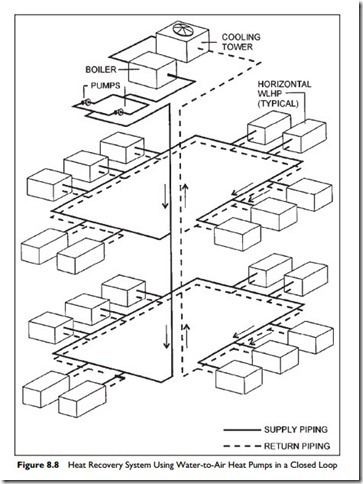Water Source Heat Pumps
Water source heat pumps are reversible refrigeration units. The refrigeration circuit is the one we considered in Chapter 6, Figure 6-6 except that one coil is water cooled/heated instead of air cooled/heated. The heat pump can either transfer heat from water into the zone or extract heat from the zone and reject it into water. This ability finds two particular uses in building air conditioning:
The use of heat from the ground
The transfer of heat around a building.
The Use of Heat from the Ground
There is a steady flow of heat from the core of the earth to the surface. As a result, a few feet below the surface, the ground temperature remains fairly steady. In cool climates, well below the frost line, this ground heat temperature may be only 40°F, but in the southern United States it reaches 70°F. This constant temperature can be utilized in two ways. Where there is groundwater available, two, properly distanced, wells can be dug and the water pumped up and through a heat pump. The heat pump can cool the water and heat the building or, in reverse, heat the water and cool the building.
Where the water is too corrosive to use, or not available, water filled coils of plastic pipe can be laid in the ground in horizontal or vertical arrays to absorb heat from, or dissipate heat into, the ground. This use of heat from the ground by a heat pump is commonly called a “ground-source heat pump.”
The ground-source heat pump provides relatively economical heating or cooling using electricity. The ground-source heat pump has a much higher cooling efficiency than an air-cooler air-conditioning unit, making it very attractive in areas where the summer electricity price is very high or supply capacity is limited. In places where other fuels for heating are expensive, the ground-source heat pump can be very attractive.
The Transfer of Heat Around a Building
The second use of heat pumps in building air conditioning is the water loop heat pump system. Here each zone is provided with one or more, heat pumps, connected to a water pipe loop around the building, see Figure 8.9. The water is circulated at 60°F to 90°F and the pipe is normally not insulated. Each zone heat pump uses the water to provide heating or cooling as required by that zone.
As you can see in Figure 8.8, there is a boiler to provide heating and a cooling tower to reject heat when the building has a net need for heating or cooling. The boiler, or tower, is used when required to maintain the circulation water within the set temperature limits. The system provides local heating or cooling at any time and each heat pump can be scheduled and controlled independently.
The question is: “why would anyone design a system that required so much equipment in a building?”
e In many buildings there are significant interior spaces that always require cooling, due to the heat from occupants, lighting, and equipment. This heat is put into the water loop and can then be used in exterior zones for heating.
e In addition, there are often times when the solar heat gain on the south side of a building requires zone cooling when the sun shines, while the north side of the building still requires heating.
e Lastly there are buildings with significant heat generation equipment, such as computer rooms, server racks, and telephone equipment, where the waste heat from these operations can be used to heat the rest of the building.
The heat pump units require regular filter changes to ensure that airflow is maintained, since they each include a direct expansion refrigeration circuit. In addition, the water circuiting must be designed to maintain a constant flow through the operating units, even when other units are removed for repair. This issue will come up again when we are discussing water piping in the next chapter, Chapter 9.
These closed loop systems are very effective in multiuse buildings, buildings with substantial core areas and heating loads, and buildings where occupancy is variable in both time and quantity. Examples include offices, hotels, commercial, colleges, and laboratories.
The Next Step
Having considered a variety of hydronic systems in this chapter we will go on in Chapter 9 to consider the pumping, piping, balancing and control of water systems.
